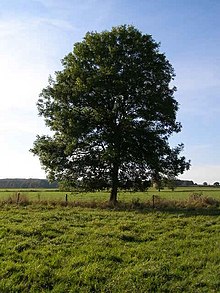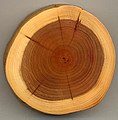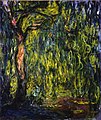Portal:Trees
The Trees Portal

In botany, a tree is a perennial plant with an elongated stem, or trunk, usually supporting branches and leaves. In some usages, the definition of a tree may be narrower, including only woody plants with secondary growth, plants that are usable as lumber or plants above a specified height. In wider definitions, the taller palms, tree ferns, bananas, and bamboos are also trees.
Trees are not a monophyletic taxonomic group but consist of a wide variety of plant species that have independently evolved a trunk and branches as a way to tower above other plants to compete for sunlight. The majority of tree species are angiosperms or hardwoods; of the rest, many are gymnosperms or softwoods. Trees tend to be long-lived, some reaching several thousand years old. Trees have been in existence for 370 million years. It is estimated that there are around three trillion mature trees in the world.
A tree typically has many secondary branches supported clear of the ground by the trunk, which typically contains woody tissue for strength, and vascular tissue to carry materials from one part of the tree to another. For most trees it is surrounded by a layer of bark which serves as a protective barrier. Below the ground, the roots branch and spread out widely; they serve to anchor the tree and extract moisture and nutrients from the soil. Above ground, the branches divide into smaller branches and shoots. The shoots typically bear leaves, which capture light energy and convert it into sugars by photosynthesis, providing the food for the tree's growth and development.
Trees usually reproduce using seeds. Flowers and fruit may be present, but some trees, such as conifers, instead have pollen cones and seed cones. Palms, bananas, and bamboos also produce seeds, but tree ferns produce spores instead.
Trees play a significant role in reducing erosion and moderating the climate. They remove carbon dioxide from the atmosphere and store large quantities of carbon in their tissues. Trees and forests provide a habitat for many species of animals and plants. Tropical rainforests are among the most biodiverse habitats in the world. Trees provide shade and shelter, timber for construction, fuel for cooking and heating, and fruit for food as well as having many other uses. In much of the world, forests are shrinking as trees are cleared to increase the amount of land available for agriculture. Because of their longevity and usefulness, trees have always been revered, with sacred groves in various cultures, and they play a role in many of the world's mythologies. (Full article...)
Cordyline australis, commonly known as the cabbage tree, or by its Māori name of tī or tī kōuka, is a widely branched monocot tree endemic to New Zealand.
It grows up to 20 metres (66 feet) tall with a stout trunk and sword-like leaves, which are clustered at the tips of the branches and can be up to 1 metre (3 feet 3 inches) long. With its tall, straight trunk and dense, rounded heads, it is a characteristic feature of the New Zealand landscape. Its fruit is a favourite food source for the kererū and other native birds. It is common over a wide latitudinal range from the far north of the North Island at 34° 25′S to the south of the South Island at 46° 30′S. Absent from much of Fiordland, it was probably introduced by Māori to the Chatham Islands at 44° 00′S and to Stewart Island / Rakiura at 46° 50′S. It grows in a broad range of habitats, including forest margins, river banks and open places, and is abundant near swamps. The largest known tree with a single trunk is growing at Pākawau, Golden Bay / Mohua. It is estimated to be 400 or 500 years old, and stands 17 metres (56 feet) tall with a circumference of 9 metres (30 feet) at the base. (Full article...)Did you know? -
- ... that fossil leaves almost identical to those of the Australian rainforest tree Orites excelsus (pictured) have been found in New Zealand?
- ... that more than 8000 trees were planted in Backmuir Wood to celebrate the 2000 millennium?
- ... that the name of the newly defined genus of macadamia-like trees, Lasjia, is derived from the initials of Lawrence Alexander Sidney Johnson?
- ... that at St Athan, a wild fig tree grew out of the cement of the East Orchard chapel walls?
- ... that in the churchyard of St Mary and St Peter's Church in Wilmington, East Sussex, there is a 1,600-year-old, 23-foot (7 m) wide yew tree?
- ... that Christopher Werner made a lifelike South Carolina Palmetto tree out of iron, copper, and brass?
- ... that seed from an endangered Chrysophyllum imperiale tree planted in Royal Botanic Gardens, Sydney in 1868 by Prince Alfred has been sent to its native Brazil to aid in recovering the species there?
Selected article -
Firs are evergreen coniferous trees belonging to the genus Abies (/ˈeɪbiˌiz/) in the family Pinaceae. There are approximately 48–65 extant species, found on mountains throughout much of North and Central America, Europe, Asia, and North Africa. The genus is most closely related to Cedrus (cedar)The genus name is derived from the Latin "to rise" in reference to the height of its species. The common English name originates with the Old Norse, fyri, or the Old Danish, fyr.
They are large trees, reaching heights of 10–80 metres (33–262 feet) tall with trunk diameters of 0.5–4 m (1 ft 8 in – 13 ft 1 in) when mature. Firs can be distinguished from other members of the pine family by the way in which their needle-like leaves are attached singly to the branches with a base resembling a suction cup, and by their cones, which, like those of true cedars, stand upright on the branches like candles and disintegrate at maturity. (Full article...)General images
Selected lists
Subcategories
Related portals
Associated Wikimedia
The following Wikimedia Foundation sister projects provide more on this subject:
-
Commons
Free media repository -
Wikibooks
Free textbooks and manuals -
Wikidata
Free knowledge base -
Wikinews
Free-content news -
Wikiquote
Collection of quotations -
Wikisource
Free-content library -
Wikispecies
Directory of species -
Wikiversity
Free learning tools -
Wiktionary
Dictionary and thesaurus















































































